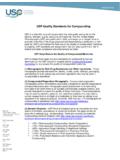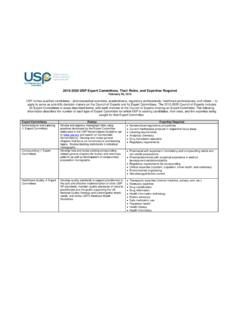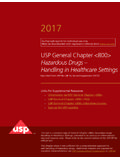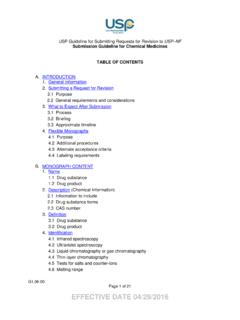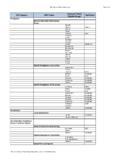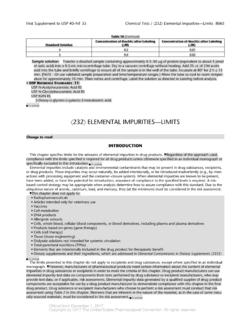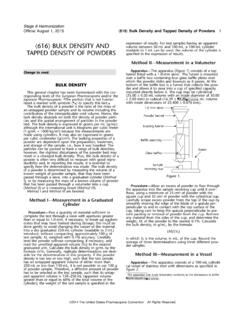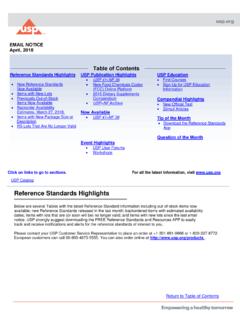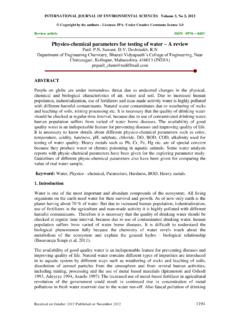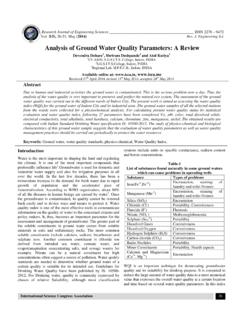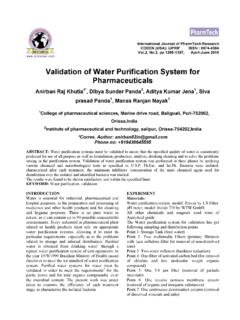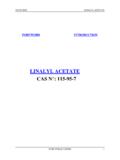Transcription of Compendial Effort to Revise Packaging Material …
1 2017 USP 1 Compendial Effort to Revise Packaging Material Standards: Glass, Plastic, Elastomer, and Other Desmond Hunt, PNP Stakeholder Forum October 19, 2017 Plastic Plastic Materials of Construction - < > Plastic Packaging System for Pharmaceutical Use - < > Plastic Component and Systems Used in the Manufacturing of a Drug Product - <665> Elastomeric components used for pharmaceutical use Injectable Drug Products - <381> Functionality testing - <382> Glass Containers Used for Pharmaceutical Use - <660> Metal Containers Used for Pharmaceutical Use - <662> Biocompatibility testing of Plastic and Elastomeric Material Biological Reactivity.
2 In Vitro - <87> Biological Reactivity, In Vivo - <88> Biocompatibility of Materials - <1031> 2 USP current efforts in revision of Packaging standards Building safety into a system by using well-characterized and safe materials of construction (Quality by Design). The testing required to select and qualify a Packaging system is correlated with the risk that the Packaging system or component will interact with the final drug product (Risk-based Approach). The USP standard serves as a baseline Should have value in every situation of use.
3 But may not necessarily address every individual situation of use 3 A starting point for the revision of USP standards Plastic materials and Packaging systems < > Plastic Material of Construction Identification Biological Activity Physico-chemical Tests Extractable Metals Plastic Additives < > Plastic Packaging Systems for Pharmaceutical Use Biological Activity Physico-chemical Tests Safety Assessment (Extractables/Leachables) Test Parameter Oral and Topical Dosage Forms All Other Dosage Forms Chemical Tests Identification DSC/IR DSC/IR Physicochemical Tests Water extraction: UV absorbance, Acidity/alkalinity TOC Water extraction: UV absorbance, Acidity/alkalinity TOC Extractable Metals Acid extraction: ICP analysis for targeted and relevant metals Acid extraction.
4 ICP analysis for targeted and relevant metals Polymer Additives Proper Reference to Indirect Food Additive Regulations, CFR 174-186 Direct chemical testing Biological Reactivity In Vitro per USP <87> Required Required In Vivo per USP <88> Not required Required as needed to obtain plastic classification < > Plastic Materials of Construction Objective: gain as much information about a Material of construction to determine potential suitability Requirements of < > can be met by: The materials of construction meeting requirements of < > The component or system meeting the requirements of < > 6 < > Material Characterization Chapter 7 Comparison of testing Required for Various Dosage Forms Test Parameter Oral and Topical Dosage Forms All Other Dosage Forms Chemical Tests Physicochemical Tests Water extraction: UV absorbance, acidity/alkalinity TOC Water extraction.
5 UV absorbance, acidity/alkalinity TOC Chemical Assessment Extractables and Leachables Risk-based testing * Risk-based testing * Biological Reactivity In Vitro per USP <87> Required Required In Vivo per USP <88> Not required Required as needed to obtain plastic classification < > Plastic Packaging Systems for Pharmaceutical Use < > and < > Sample comments Biological Reactivity testing Comment/Concern: Biological reactivity testing for SODF does not seem to be appropriate for the level of risk. USP Position: A cornerstone of suitability for use assessment of Packaging systems and their materials of construction is the concept of orthogonal assessment.
6 Individual means of assessment are generally insufficiently robust or broad in scope to provide rigorous and complete assessments on their own, thus orthogonal assessments are preformed to essentially fill the gaps in the individual assessments. PF 42 (4) July 2016: Proposed the removal of the Biological reactivity testing for SODF and Topical Dosage Forms TOC and Absorbance testing Comment: Materials that would not pass the test that could still be used for certain applications Planned Revision: If the specification for absorbance or TOC is exceeded, then the Material or Packaging system can still be deemed acceptable if the chemicals responsible for the test results can be established (identity and concentration) and the chemicals are safety assessed to establish that the probable safety risk posed by all the chemicals, considered individually, is within acceptable parameters.
7 < > and < > Sample comments (cont ed) Extractable Metal testing Comments: Some of the metals specified in < > are fundamentally misaligned to <232> Metal specifications in the chapter are not based no clear basis from either a toxicological or quality perspective and should be removed < > should directly reference <232> because the chapter already discusses the contributions of Packaging components to the final drug product. < > Comments The concept of relevant elements a relevant element is one which is a known constituent of the Material or component that could potentially arise from a starting Material , additive, or manufacturing process and elements of known toxicological concern as outlined in <232>.
8 Nontoxic elements that are intentionally added because of potential drug product sensitivities and interactions < > Comments Extractable Metal testing Comments: Metals specified in < > are fundamentally misaligned to <232> Metal specifications in the chapter are not based on either a toxicological or quality perspective POLYVINYL CHLORIDE, PLASTICIZED Arsenic, cadmium, lead, mercury, cobalt, nickel, and vanadium: Report the measured value in Solution S3 at values above mg/L (ppm), corresponding to mg/g. If the measured values are below these values, report the result as less than mg/L (ppm), corresponding to less than mg/g.
9 Barium: S3 contains NMT mg/L (ppm), corresponding to 5 mg/g. Calcium: S3 contains NMT 35 mg/L (ppm), corresponding to weight %. Tin: S3 contains NMT 1 mg/L (ppm), corresponding to 20 mg/g. Zinc: S3 contains NMT 100 mg/L (ppm), corresponding to weight %. < > Comments Extractable Metal testing Comments: < > should directly reference <232> <232> already discusses the contributions of Packaging components to the final drug product. USP Position: <232> limits don t apply to < > The focus has been on the risk assessment option in <232> How to get the necessary data to make a decision regarding the selection of a Material for a new product or for a Packaging Material change.
10 In the control of plastic materials, extractable metals is an important attribute to understand and testing seems to be the only way to obtain the necessary data. < > Comments Grandfather: currently approved products Rationale Goal of <661> revision To aid in the selection and qualification of Packaging materials and components that are deemed suitable and safe Suitability and safety of a Packaging system, with its drug product, is determined by regulatory authorities A Packaging system, with a specific drug product, would meet the requirements of < > and < >, if it had gained regulatory approval.
